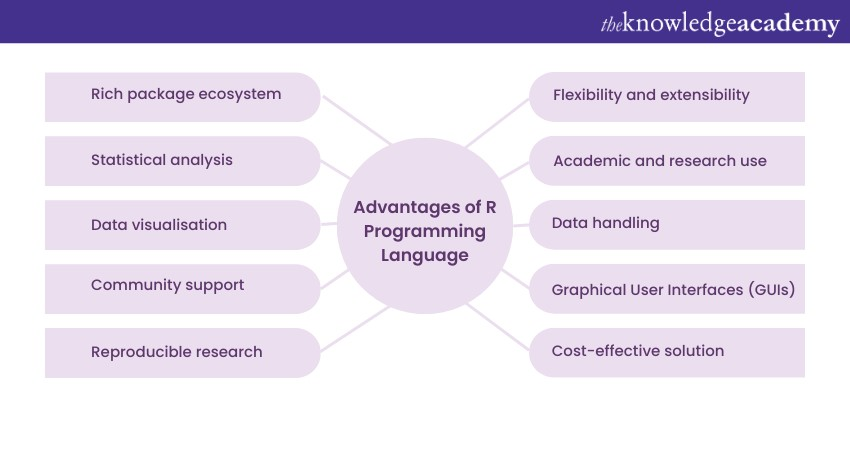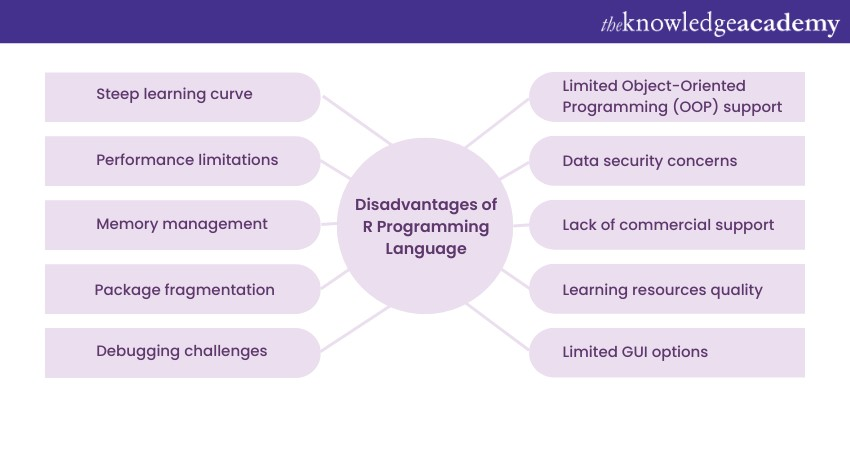We may not have the course you’re looking for. If you enquire or give us a call on 01344 203999 and speak to our training experts, we may still be able to help with your training requirements.
We ensure quality, budget-alignment, and timely delivery by our expert instructors.

So, if you want to know the pros and cons you might face using R Programming Languages, you have come to the right place. In this blog, we will learn about R programming and also focus on the different Advantages and Disadvantages of R programming. Read more to find out!
able of Contents
1) What is R Programming Language?
2) What are the Advantages of R Programming Language?
3) What are the Disadvantages of R Programming Language?
4) Why should you use R Programming Language?
5) Conclusion
What is R Programming Language?
R is a Programming Language and free software environment specifically designed for statistical computing and graphics. It has become one of the leading tools for data analysis, statistical modelling, and visualisation.
To help you better understand R Programming, here are some key features of R programming:
1) Comprehensive: R provides various statistical techniques, including linear and nonlinear modelling, classical statistical tests, time-series analysis, classification, clustering, and more.
2) Graphics: R has extensive and flexible graphics capabilities for data visualisation. Base graphics are included, but many packages like ggplot2 offer advanced plotting capabilities.
3) Packages: One of R's strengths is its vibrant and active community. This has resulted in many user-contributed packages extending R's capabilities. The Comprehensive R Archive Network (CRAN) is a repository that holds thousands of these packages.
4) Data handling: R possesses an array of tools and packages for importing, cleaning, and wrangling data, making it a versatile tool for data analysis.
5) Programming: R is a functional and object-oriented programming language. This allows you to create your own functions, use looping, and create custom objects, among other capabilities.
Enhance more in-depth knowledge about Programming with our course on Programming Training.
What are the Advantages of R Programming Language?
In this section, we will discuss the advantages of R Programming Languages. They are as follows:

1) Rich package ecosystem: R boasts an extensive collection of packages available on CRAN, Bioconductor, and GitHub, covering a wide range of data analysis and statistical tasks. These packages provide ready-to-use functions and tools, saving time and effort in implementing complex algorithms.
2) Statistical analysis: R's strong foundation in statistics makes it a powerful tool for conducting various statistical analyses, such as linear and nonlinear modelling, time series analysis, hypothesis testing, and more. You can use the built-in functions and libraries. You can access complex statistical tasks with varying levels of expertise.
3) Data visualisation: R's visualisation libraries, particularly ggplot2, offer a highly flexible and elegant way to create various data visualisations. You can generate publication-quality plots, charts, and graphs to communicate insights from their data effectively.
4) Community support: R benefits from an active and enthusiastic community of users, developers, and researchers. This community-driven approach fosters collaboration, knowledge-sharing, and the continuous development of new packages and functionalities.
5) Reproducible research: RMarkdown and knitr facilitate reproducing research by combining code, data, and analysis results in a single document. This capability ensures that your research findings can be easily replicated and shared with others.
6) Flexibility and extensibility: R's flexible nature allows you to create custom functions and tailor analyses to your specific needs. Additionally, R's capability to interface with other Programming Languages like C, Python, and Java enhances its extensibility.
7) Academic and research use: R has become the Language of choice in academia and research due to its statistical prowess and open-source nature. Researchers can conduct advanced data analysis and publish their work, contributing to the growing body of knowledge.
8) Data handling: R offers seamless data handling capabilities, allowing you to import, clean, and manipulate data efficiently. This flexibility is beneficial when dealing with real-world datasets requiring pre-processing and transformation.
9) Graphical User Interfaces (GUIs): While R is primarily command-line based, several GUIs, such as RStudio, R Commander, and Jupyter Notebooks, enhance its usability, making it more accessible to beginners. If you are just starting out, you will like this language because it uses a graphical interface.
10) Cost-effective solution: As an open-source Language, R is free to use and redistributable. This cost-effectiveness makes it an attractive option for individuals like you or organisations looking to leverage powerful Data Analysis capabilities without any significant financial investment.
Enhance your knowledge of R Programming with our comprehensive guide on R Programming.
What are the Disadvantages of R Programming Language?
Like every programming language, R also has its disadvantages. Some of these disadvantages are listed below:

1) Steep learning curve: R's unconventional syntax and extensive package ecosystem can make it challenging for beginners to grasp. Learning R requires more time and effort for a beginner than other programming languages.
2) Performance limitations: R's interpreted nature can lead to performance issues when handling large datasets or complex calculations. It may not be the best choice for high-performance computing tasks.
3) Memory management: Inefficient memory management in R can be a drawback, especially when dealing with large datasets. You can encounter memory allocation errors or slow performance.
4) Package fragmentation: The vast number of packages available can lead to package fragmentation. This is where different packages have overlapping functionalities or are not well-maintained, potentially causing compatibility issues.
5) Debugging challenges: R's error messages may not always provide clear guidance to you. Hence, debugging and identifying the root cause of issues is challenging, especially for amateurs.
6) Limited Object-Oriented Programming (OOP) support: R's support for Object-Oriented Programming is not as robust as other languages like Java, Python or R Programming. This limitation can restrict certain programming and software design.
7) Data security concerns: As an open-source Language, R may raise security concerns when handling sensitive data in commercial or proprietary environments. Ensuring data privacy and security requires careful consideration.
8) Lack of commercial support: R Programming Language has an open-source nature. This means that there is no single entity providing official commercial support. Organisations relying heavily on R may face challenges in getting dedicated professional support.
9) Learning resources quality: With the vast amount of learning resources available, there will be variations in the quality and accuracy of tutorials and documentation. This can lead to confusion and misinformation. So, you have to be careful about where you are getting your information from.
10) Limited GUI Options: While R has GUIs like RStudio and R Commander, you may find the available graphical interfaces less comprehensive than other data analysis tools.
Gain more in-depth knowledge about OOP with our Object-Oriented Fundamentals Training.
Why should you use R Programming Language?
There are several reasons why you should choose R programming language, particularly in domains like Data Analysis, Statistics, and research. Here are some reasons:
1) Statistical capabilities: R was specifically designed for statistics. It offers a broad array of statistical tests, models, and analyses, making it an essential tool for statisticians and Data Analysts.
2) Graphics and visualisation: R is renowned for its capabilities in data visualisation. Users can create high-quality, customisable plots and visualisations with libraries like ggplot2, lattice, and base graphics.
3) Comprehensive package ecosystem: The Comprehensive R Archive Network (CRAN) houses thousands of user-contributed packages that extend R's capabilities. This means that for almost any analytical task, there's likely a package that already implements it.
4) Open source: Being open-source means R is free to use, and its codebase can be examined and modified. This fosters a collaborative environment where tools and packages are continuously developed and improved by the community.
5) Active community: R's active and vibrant community ensures that you have access to plenty of tutorials, forums, workshops, and online courses. This makes it relatively easier to find answers to questions or solutions to problems.
6) Flexibility: R can integrate with other languages (like C++, Python, and SQL) and tools, making it versatile for various applications, from web apps to reporting.
7) Data manipulation tools: Packages like dplyr, tidyr, and data.table provides robust tools to manipulate data efficiently. This allows you to reshape, aggregate, filter, and transform data easily.
8) Reproducibility: R, combined with tools like RMarkdown, allows for creating reproducible research documents that combine code, output, and narrative in a single document. This is invaluable in academic, scientific, and business reporting.
Conclusion
R programming proves to be a powerful ally for data analysis and statistical computing. With its extensive package ecosystem, statistical capabilities, and visualisation tools, R enables you to glean valuable insights from complex datasets. Despite some challenges, its advantages make it a preferred choice for data enthusiasts and professionals alike.
Unlock your coding potential with our comprehensive guide on Swift Programming Language.
Frequently Asked Questions
Upcoming Programming & DevOps Resources Batches & Dates
Date
 R Programming Course
R Programming Course
Fri 28th Feb 2025
Fri 4th Apr 2025
Fri 27th Jun 2025
Fri 29th Aug 2025
Fri 24th Oct 2025
Fri 5th Dec 2025






 Top Rated Course
Top Rated Course



 If you wish to make any changes to your course, please
If you wish to make any changes to your course, please


